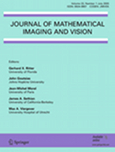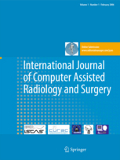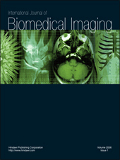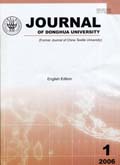AYMERIC HISTACE
| Home | CV | Research | Publications | Teaching |
Journal articles (8)
2013 |
Statistical Model of Shape Moments with Active Contour Evolution for Shape Detection and Segmentation
Zhang, Y. and Matuszewski, B.J. and Histace, A., and Precioso, F. In: Journal of Mathematical Imaging and Vision, Springer, ISSN 0924-9907, Special Issue on Computer Analysis of Images, 2013, In press. Abstract :
This paper describes a novelmethod for shape
representation and robust image segmentation. The proposed
method combines two well known methodologies,
namely, statistical shape models and active contours
implemented in level set framework. The shape detection
is achieved by maximizing a posterior function that
consists of a prior shape probability model and image
likelihood function conditioned on shapes. The statistical
shape model is built as a result of a learning process
based on nonparametric probability estimation in
a PCA reduced feature space formed by the Legendre moments of training silhouette images. A greedy
strategy is applied to optimize the proposed cost function
by iteratively evolving an implicit active contour
in the image space and subsequent constrained optimization
of the evolved shape in the reduced shape feature
space. Experimental results presented in the paper
demonstrate that the proposed method, contrary
to many other active contour segmentation methods, is
highly resilient to severe random and structural noise
that could be present in the data.
|
2012 |
Useful Noise effect for nonlinear PDE based restoration of scalar images
Histace, A., and Rousseau, D. In: International Journal of Computer Information Systems and Industrial Management Applications, ISSN 2150-7988, 2012, Vol. 4, pp 411-420. Download pdf Abstract :
It is progressively realized that noise can play a
constructive role in the domain of nonlinear information processing.
This phenomenon, also known as stochastic resonance
(SR) effect, has experienced large varieties of extensions with
variations concerning the type of noise, the type of information
carrying signal or the type of nonlinear system interacting
with the signal-noise mixture. In this article, we propose an
interpretation for the mechanism of noise-enhanced image
restoration with nonlinear PDE (Partial Differential Equation)
recently demonstrated in literature. More precisely, a link
is established between the action of noise in a nonlinear
PeronaÐMalik anisotropic diffusion and stochastic resonance in
memoryless nonlinear systems for 1-D signals. For illustration
some preliminary results are presented on classical ÒcameramanÓ
image and the inner of SR mechanism is theoretically and
practically studied using a simple set of parameters regarding
the PDE used and the modeling of boundaries within images.
|
2011 |
Comparison of Different Grid of Tags Detection Methods in Tagged Cardiac MR Imaging (Long Version)
Histace, A., and Portefaix, C. and Matuszewski, B. In: International Journal of Computer Assisted Radiology and Surgery, ISSN 1861-6429, Springer, 2011, Vol. 6(2), pp. 153-161, doi: 10.1007/s11548-010-0495-7, published online 06/2010. Download pdf Abstract :
Purpose: Noninvasive imaging assessment of cardiac function is important
in cardiovascular disease diagnosis, especially for evaluation of local cardiac motion.
Tagged Cardiac MRI has been developed for this purpose, but evaluation of the results
requires quantification and automation. Method: Two methods utilizing active
contour modeling for wall motion extraction based on tagged cardiac MRI scans were
evaluated based on properties of tracking methods in the image domain and frequency
domain. Three criteria were used: accuracy, inter-subject and intra-subject sensitivity.
The tracking results were evaluated by a medical expert. The evaluation methodology
and its possible generalization to other diagnostic methods were considered. Results:
Image-domain and frequency-domain analysis of tagged cardiac MRI data sets were
evaluated demonstrating that the image domain method provides better results. The
image-domain method method is much more resistant to changes in the data, this
time, due to a different subject being scanned. The frequency domain approach is not
suitable for clinical applications, as the global error is significantly increased (more
than 20%). Conclusion: The image-domain method was found most effective, and it
can generate a set of clearly identified parameters. The evaluation approach can be an
interesting alternative to classical psychovisual studies which are time consuming and
often fastidious for clinicians.
|
2009 |
Selective diffusion for oriented pattern extraction: Application to tagged cardiac MRI enhancement
Histace, A., and Ménard, M., and Cavaro-Ménard, C. In: Pattern Recognition Letters, ISSN 0167-8655, 2009, Vol. 30(15), pp. 1356-1365, doi:10.1016/j.patrec.2009.07.012. Download pdf Abstract :
Anisotropic regularization PDE’s (Partial Differential Equation) raised a strong interest
in the field of image processing. The benefit of PDE-based regularization methods lies in the ability
to smooth data in a nonlinear way, allowing the preservation of important image features
(contours, corners or other discontinuities). In this article, a selective diffusion approach
based on the framework of Extreme Physical Information theory is presented. It is shown that
this particular framework leads to a particular regularization PDE which makes the integration
of prior knowledge possible within the diffusion scheme. As a proof of feasibility, results of
oriented pattern extractions are first presented on ad hoc images and second on a particular
medical application: Tagged cardiac MRI (Magnetic Resonance Imaging) enhancement.
|
2009 |
Segmentation of myocardial boundaries in tagged cardiac MRI using active contours: a gradient-based approach integrating texture analysis
Histace, A., and Matuszewski, B., and Zhang, Y. In: International Journal of Biomedical Imaging, ISSN 1687-4188, 2009, Vol. 2009 , doi:10.1155/2009/983794. Download pdf Abstract :
The non invasive assessment of cardiac function is of first
importance for the diagnosis of cardiovascular diseases.
Among all medical scanners only a few enables radiologists to
evaluate the local cardiac motion: Tagged Cardiac MRI is one of them.
This protocol generates on Short-Axis (SA) sequences a dark grid which
is deformed in accordance with the cardiac motion.
Tracking the grid allows specialists a local estimation of cardiac geometrical
parameters within myocardium. The work described in this paper
aims to automate the myocardial contours detection in order to optimize the
detection and the tracking of the grid of tags within myocardium.
The method we have developed for endocardial and epicardial contours
detection is based on the use of texture analysis and active contours models.
Texture analysis allows us to define energy maps more efficient than those
usually used in active contours methods where attractor is often based
on gradient and which were useless in our case of study, for quality of tagged cardiac MRI is very poor.
|
2006 |
Analyse d’Images IRM cardiaques marquées
Histace, A., and Cavaro-Ménard, C., and Courboulay, V. and Ménard, M. In: Traitement du Signal, ISSN 0765-0019, Vol. 23(2), pp. 125-143, 2006. Download pdf Abstract :
The noninvasive evaluation of the cardiac function presents a great interest for the diagnosis of cardiovascular
diseases. Cardiac tagged MRI allows the measurement of anatomical and functional myocardial parameters. This
protocol generates a dark grid which is deformed with the myocardium. As a consequence, the tracking of the grid
allows the displacement estimation in the myocardium. The work described in this paper aims to automate the
myocardial contours detection and the following of the grids of tags on Short-Axis time sequences, in order to firstly
optimize the 2D+T study of the parietal contractions and secondly make possible its clinical use. The method we have
developed for endocardial and epicardial contours detection is based on the use of texture analysis and active
contours models. Texture analysis allows us to define energy maps more efficient than those usually used in active
contours methods where attractor is often based on gradient and which were useless in our case of study. The follow-up
of the grid of tags that we have implemented is based on a grid of active contours (B-snakes) which part of
the energy is issued from a particular selective diffusion process which leading equation is based on the recent work
of [8]. The results obtained with our method is fully automatic and correct on Short-Axis sequences, when previous
works on cardiac tagged MR images analysis always used manual contours detection.
|
2006 |
Constructive Action of Noise for Impulsive Noise Removal in Scalar Images
Histace, A., and Rousseau, D. In: Electronics Letters, ISSN 0013-5194, Vol. 46, pp. 393-395, 2006. Download pdf Abstract :
We propose a nonlinear variational approach to remove impulsive noise in scalar images.
Taking benefit from recent studies on the use of stochastic resonance and the constructive
role of noise in nonlinear processes, our process is based on the classical restoration process
of Perona-Malik in which a Gaussian noise is purposely injected. We show that this new
process can outperform the original restoration process of Perona-Malik from which it is inspired.
|
2004 |
A New Paradigm for the Extraction of Information: Application to Enhancement of Visual Information in a Medical Application
Courboulay, V., and Histace, A., Ménard, M. and Cavaro-Ménard, C. In: Journal of Dong Hua University (English Edition), ISSN 1672-5220, Vol. 21(3), pp. 111-116, 2004. Download pdf Abstract :
The noninvasive evaluation of the cardiac function presents
a great interest for the diagnosis of cardiovascular diseases.
Tagged cardiac MRI allows the measurement of
anatomical and functional myocardial parameters. This
protocol generates a dark grid which is deformed with
the myocardium displacement on both Short-Axis (SA) and
Long-Axis (LA) frames in a time sequence. Visual evaluation
of the grid deformation allows the estimation of the
displacement inside the myocardium. The work described
in this paper aims to make robust and reliable the visual
enhancement of the grid tags on cardiac MRI sequences,
thanks to an informational formalism based on Extreme
Physical Informational (EPI). This approach leads to the
development of an original diffusion pre-processing allowing
us to make better the robustness of the visual detection
and the following of the grid of tags.
|